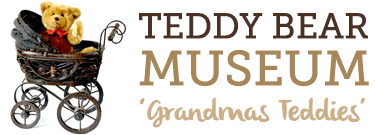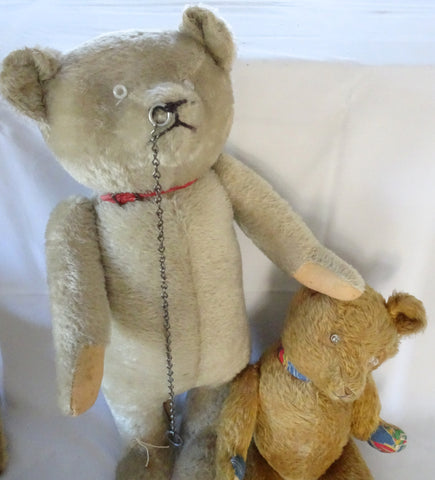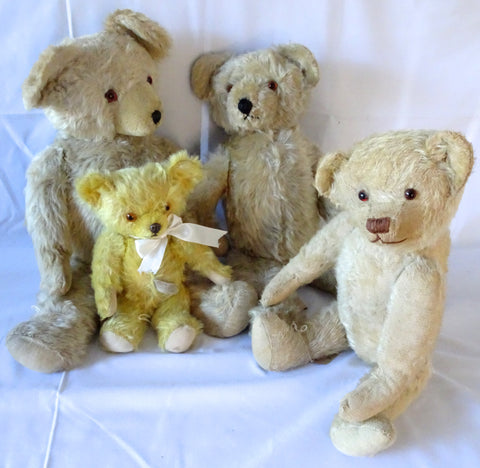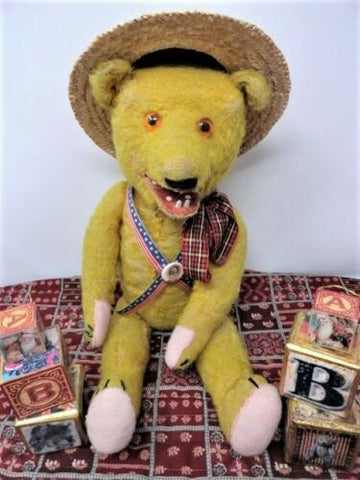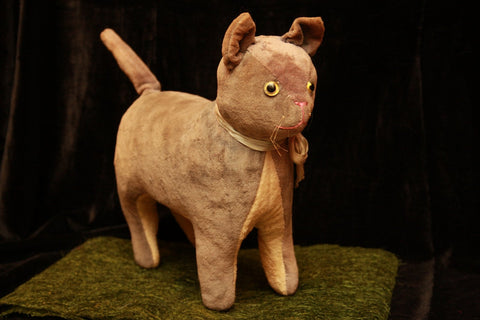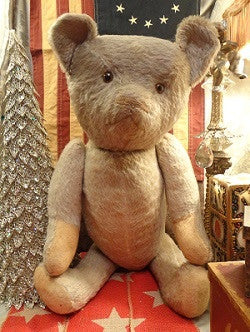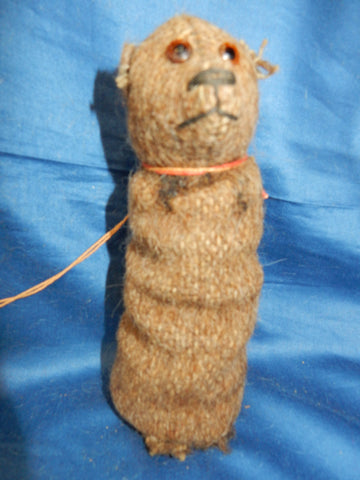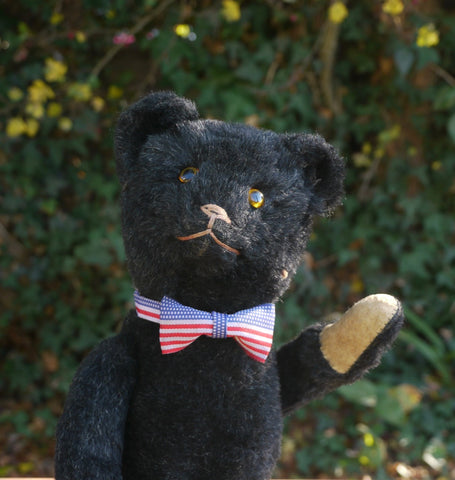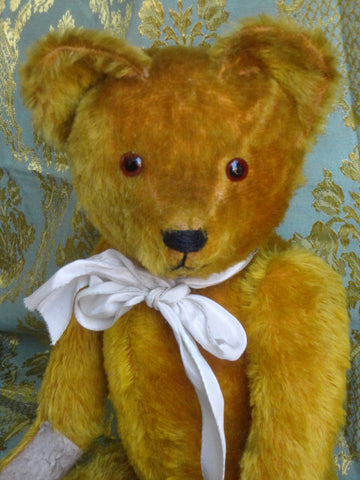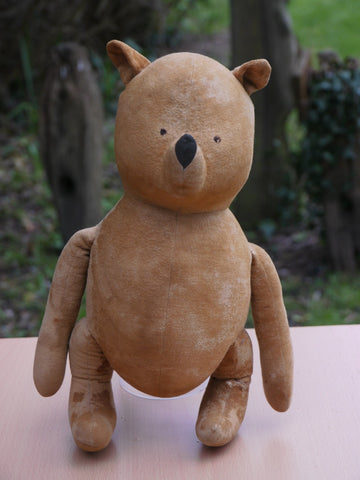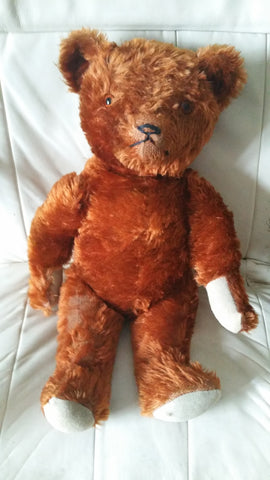American
Americans would say that they produced the first toy bear in about 1902. After President Roosevelt refused to shoot a real one, toy bears became known as "Teddy's" bears in his honour. The Ideal Toy and Novelty Company began in 1902/3 and the Columbia Teddy Bear Manufacturers introduced the "Laughing Roosevelt" in 1907. Other well known early makes included Knickerbocker (1920), Bruin, Aetna and Gund.
American bears are identified by:-
• Long firm bodies.
• Short straight limbs.
• Long sloping muzzles often shaved.
• Boot button eyes set close together.
• Horizontally stitched noses.
• Ears folded into the head seam or set low on the head.
Knickerbocker Toy Company (1869 – 1984)
The Knickerbocker Toy Company was founded in Albany, New York State in 1869 and produced educational toys such as wooden lithographed alphabet blocks and puzzles. Later in 1968 the firm moved to Middlesex, New Jersey, and imported their sewn component parts from Korea.
Dutch settlers were known as ‘Knickerbockers’ in New York, a tradition derived from Washington Irving's ‘A History of New York’, a fictitious account told by a Dutchman, Diedrich Knickerbocker, who wore rather outrageous puffed-out trousers.
During the 1920’s Knickerbocker turned to making soft toys and were early teddy bear makers of distinction. The early bears were predominantly made in either gold, brown or white mohair. They had wide, triangular shaped heads which were somewhat flat topped. With large, rounded ears and blunt muzzles. Their bodies were often slimmer than those of European bears of the same period; and did not have humps on their backs. Their paw pads were often made of velveteen.
Labelling: Initially sewn at tummy level, they had a pale yellow woven single-ply label sewn into the centre seam, quite exposed to wear and tear. Printed with the company horseshoe logo and the words ‘Knickerbocker Toy Co – New York’. Later bears in the 1950’s bears had labels reading ‘Animals of Distinction’ sewn into their left side seam. This was the company’s slogan. The reverse side read ‘Made under sanitary laws.’
During the post WWII years their bears acquired an inset muzzle, often made in a different material to the rest of the bear. From the 1950’s Knickerbocker developed bears which were more varied in shape i.e. inverted ears are particularly characteristic of the Knickerbocker brand.
Knickerbocker’s most famous bear is Smokey, the forest ranger, who was to teach American children as well as adults about forest fire prevention. Versions of Smokey were made by Ideal, Knickerbocker and Dakin. Knickerbocker were given the license after Ideal from 1968 – 1977 for the American Forest Fire Prevention Campaign. Named after Smokey Joe Martin, a famous New York Fire Fighter. Smokey bear was initially introduced in 1944 and is typically seen wearing denim trousers, a belt buckle, badge and a yellow hat. Knickerbocker’s Smokey bear was very poopular and many produced including a version that included a built in tape reminding his owners how to prevent fires.
A Kinckerbocker dark brown bear in the 1920’s became known as the ‘fertility bear’ as when it’s owner gave it to her daughter who was having problems conceiving, she told her to put it at the foot of their bed and within four years she had had three children. And later when one of the granddaughter s was also having trouble conceiving and the bear was said to work his magic again!
The gift division of Knickerbocker, ‘Applause’ was sold to Wallace Berrie in 1982. Knickerbocker ceased business in the 1984 when they went bankrupt and ceased trading and were taken over by CBS Inc.
A family named Knickerbocker began trading as The Knickerbocker Bear Company in 1990, but these bears are unrelated.
The Hermann Dynasty
This is one of the oldest family owned manufacturers of teddy bears in Germany. Two German stuffed toy factories bearing the Hermann name: Gebruder Hermann GMbH & Co KG and Hermann-Spielwaren GmbH. The Hermann family enjoyed great success in the interwar years.
The present owners are distant cousins, descended from Johann Hermann. He was a Sonneberg toymaker who made splendid bears and the family have continued the tradition, through three generations. Early Hermann bears closely resemble their Steiff cousins and because they only bore a tie on paper tag, this was easily lost and the bear not easily identified. A lack of a label doesn’t matter as quality bears out their pedigree.
They moved their present factories in West Germany following the WWII. Hermann produce plush mohair bears, with rounder and more cub like than Steiff bears.
Johann Herman (1854-1919) founded a toy business c.1907 in Neufang, near Sonneberg, at that time the centre of the world’s toy industry. He had six children who all became involved in teddy-bear manufacturing. The first Hermann bear was made on 24th October 1913 by Adelheid (1891-1939), his daughter.
When Johann died in 1919, his second son, Artur (1894-1989) moved to Sonneberg, to start his own firm and recognised that success lay in his father’s reputation. Artur’s trademark was a walking teddy bear leading a bear on all fours, carrying a monkey, and later a crown with “Rex” on the rim.
Both Hermann companies continue to trade as family firms. They developed their own distinct styles. The bears produced in the 1920’s had smaller feet associated with a period of much greater economy.
Hermann-Spielwaren GMbH
After WWI, Max Hermann remained in Neufang, founded his own firm in 1920 at the family home. In 1923 he moved to Sonneberg with his wife Hilde Stammberger (1898-1985) and their son Rolf-Gerhard (born 1922). Hilde was a graduate of the Sonneberg Trade School and trained as a toymaker, she gave Hermann teddy bears their special character. The teddies bow designed by Hilde was matched to the colour of the bear’s fur coat.
Max used the trademark “Maheso” derived from the first two letters of the words “Max Herman Sonneberg” and later added the teddy bear and the running dog logo within a distinctive green triangle (swing tag) now a famous trademark.
N.B. Gebruder Hermann’s trademark is a circular disc with “Hermann Teddy Original” initially bronze with red writing, then gold with green writing and then red (plastic) with gold writing embossed on the surface.
In the 1920’s the company produced a range of ten teddy bears which varied in size from 8” – 27” (20-70cm). Hermann bear models are assigned a five figure number: the first three for the shade of mohair; the last two for the size i.e. 112/50; this is still used today. They were produced in gold coloured plush fur: Old Gold; Caramel Gold: Yellow Gold and Golden Brown and each bear had a huge silk bow around its neck. The first thing the new apprentice learnt was how to tie the ribbon in the bow, an intricate skill.
It became fashionable in the 1920’s and 1930’s to dye the tips of the mohair plush a different colour and this trend lasted a long time. They extended the range to include other soft toys i.e. elephants, dogs but the teddy bear was the main seller.
In 1947 Rolf-Gerhard joined the firm. When Max died in 1955, he took over the firm which became a public limited company, named Hermann-Spielwaren GmbH in 1979. Until her death in 1992, his wife Dora-Margot designed many of the bears.
Rolf-Gerhard and his daughter Ursula now run the company. Since 1993, all bears have been fitted with
1910’s – Karel Pospisil founded Hamiro factory in a village iron mill near Rokycany, in what was west Bohemia, producing lead figures and tin soldiers.
1919 – as it was felt their customers may be tiring of military toys after WWI to introduce newness Karel’s wife Emilie (Miluse) designed a textile rabbit to boost sales. Emilie had spent the war years in France where she learned how to design and sew soft toys. She established a soft toy company at an old forge and employed 12 people. Hamiro exhibited at European trade fairs and exported 60% of production overseas.
1925 – 48 Wilhelmine Walter made Kersa bears at Lobosite, then in Bolivia, Eastern Europe.
1928 – 1988 their designer, Marcia Hybinova was most well known for her hand puppet designs.
1929 Hamiro moved from the country to a new and larger factory in small western town of Rokycany. Pospisil got a license for building the soft toy factory.
1932 the Hamiro trademark was registered. The name an acronym from “hamr” (iron mill), “Miluse” (pet name for his wife) and “Rokycany”.
1936 – 38 was now an international business with 500 employees and the 2nd largest plush toy manufacturer in Europe. They offered a wide range of toys including: teddy bears, dogs, cats, rabbits, zebras, elephants, monkeys and lions. They also produced puppets and dolls. Mostly made from mohair, stuffed with wood wool with hand painted details. They won design prizes regularly.
1937 – Pospisil was asked by the Irish Free State to help with establishing a soft toy industry in Ireland.
1939 – 45 during WWII during the war years toy production was limited and Hamiro produced war materials i.e. military uniform repair and production of underwear.
1948 – the company was nationalised and operating as a ‘people owned’ enterprise in a small town of Pribram. Karel and Miluse’s son, Libor manages to hide the firms archive in the attic.
1973 - Libor Pospisil kept working in the company in quality control until his retirement and in 1973 he died.
1989 – the Velvet Revolution brought the end of Hamiro. Some pre-WWII designs were taken over by the company Sigikid, which then put out a signature line under the name “Miro” in 1992 (they had the tag “Made in CSFR”). The attempt to restart teddy bear production in Czech Republic was not very successful.
Hamiro bears and friends are sometimes not readily identified or confused with the Austrian company Fletcher or even Schuco. Hamiro have a history of quality made products.
The company was a very successful manufacturer in the mid to late 20th century in Czechoslovakia with a predominance of production exported into Western Europe. Their bears typically were big, chunky with inset snout and paw pads in a contrast clipped mohair. Other smaller bears had drop-shaped paws with a triangular chin.
Their company logo changed from a dove to a teddy bear head. Paper tags on their animals 1950’s – 1960’s, with a green outline of a coniferous tree, a red cogged wheel and the letters “Ha”.
Gund Manufacturing Company (1898 – current day)
Gund is one of America’s top names and the oldest soft toy company. It is renowned worldwide for it’s quality soft plush animals. The current owners of Gund are direct descendents of Jacob Swedlin.
In 1898 German immigrant, Adolph Gund founded Gund initially as a novelty and soft toy manufacturer. Making teddy bears started in 1906 as a response to a customer request. The story is that he bought himself a few yards of plush, took the materials home and made four different sizes of teddy bear ranging from 10” – 16” tall. He had a small shop in Norwalk, Connecticut was the birthplace of Gund and moved a few years later to New York city. Early products appear to have been unmarked.
The United States was relatively untouched by WWI so the teddy bear industry continued to prosper. The first bears produced by Gund were in a silk plush.
The founder Adolph Gund retired in 1925, his assistant, Jacob (Jack) Swedlin (a Russian emigree) bought the company for a token sum. Three of Swedlins’ brothers joined him to help manage and develop J. Swedlin Inc. (the company name changed in 1925 although they kept Gund as their trade name). Swedlin at 14yrs old had started in a junior role in the factory initially in 1909. He was supporting his emigrant Russian family where he was the oldest of seven children. His interest, hard work and enthusiasm for soft toy production soon got him noticed. He trained in pattern cutting, manufacturing and design. Credit for Gunds’ success can be given to Swedlin. He expanded the range produced and after 1927 produced the “Gee-Line” of jumping animals. He changed a number of manufacturing methods. One of the most important ones was the die-cutting process using a mallet and a shaped piece of metal against pieces of cloth. This limited the number of plies that could be cut and the cutting quality could vary. Swedlin developed the use of a clicking machine which cut many more layers at a time and with greater accuracy.
1930’s Gund bear – (early bears whose proven identity are rare to find) had large round googly eyes made of celluloid and gave a comical stare. The black pupils within the eye moved freely with the outer circle edges, enabling the bear to turn his gaze in different directions. Short stout limbs which curved at the wrist and ankle. The paws were spoon shaped, the foot pads round and stubby. The paws were made of felt without claws. All four limbs were jointed. Ears were set wide apart, large, round and slightly cupped. A large round head, a pointing and protruding snout in a short pile plush. A vertically stitched shield-shaped nose and smiling mouth in a black thread. Wool plush in a cinnamon shade was popular. A short round body gave a reassuring cuddly appearance. In profile he had a slightly humped back traditional to American bears of this period.
Identification of Gund toys will be difficult as prior to 1940 there were no laws requiring sew in labels. In the 1940’s the firm grew rapidly due to the lack of European competition, and in 1946 they adopted a new trade mark of a rabbit faced “G”. After WWII Gund enjoyed enormous success, as Walt Disney granted it exclusive rights to produce soft toy versions of Disney animations in 1948.
Their bears were made of cotton plush, a few such as their version of Winnie the Pooh and the googlie-eyed bears, the former sold in Sears stores in the USA. In 1948 ‘Teddigund’ was produced in the 1940’s in a variety of fabrics and the capital ‘G’ rabbit’s head label was first used.
After WWII Gund moved to Brooklyn and produced the “Dreamies” series, unjointed bears in modern synthetics. In the 1940’s a Cowboy bear, 1947 a Jumbo Cuddle Panda, 1952 saw the ‘Cubbigund Cuddle Bear’, 1950 a sitting bear, In the 1970’s Gund was revolutionary in offering ultra soft toys made in multi-filament mod-acrylic plush fur fabrics. Fortunately, precise names of each teddy were included on their labels, making identification simple. Their main focus was stuffed toys based on the Disney characters.
Gund went on to produce stuffed versions of King Features and Hanna Barbara cartoon characters, including the latter’s Yogi Bear. This cheerful park inhabitant, named after the US baseball player Yogi Berra, was a huge success when he was introduced to the US TV viewers in the 1960’s, guaranteeing sales for Gund’s merchandise. Gund was also amongst the first US firms to produce teddy bears with inset vinyl faces, along with Ideal, Knickerbocker and other less well known companies.
In 1964 they obtained the right to manufacture Winnie the Pooh characters and still hold the license to do so.
During the 1960’s and 1970’s, the face of the teddy bear manufacturing was transformed. At the beginning of the period the vast majority of bears were produced for children. Makers gradually designing teddies that were softer and more huggable than before. Gund in the USA, was particularly good at this, with it’s technical under-stuffing of it’s toys so that they were very floppy. Generally children's bears from this period were smaller and often unjointed.
Until 1971 their factory was located in Brooklyn with their offices in New York city. Then in 1973 they moved to Edison, New Jersey and in 1979 redesigned their stuffed bears to sell as upmarket collectables like the extra-soft ‘Collectors Classics’ directed at adult collectors. They introduced the Gund ‘Bialosky’ bears in 1982. In 1983 they produced their Anniversary Gundy Bear celebrating their 85th birthday, followed by special anniversary annual bears every year.
In the early 1990’s the US toy manufacturer Gund had exclusive rights for distribution of Canterbury Bears in Canada and the USA starting with 10 new limited edition teddies. In 1991, a new limited edition, handmade ‘Signature Collection’. Today the firm is larger than ever, with many of it’s bears made in the Far East.
The firms slogan is “Gotta Getta Gund”.
To find American bears for sale go to the search box and type "American for sale"
